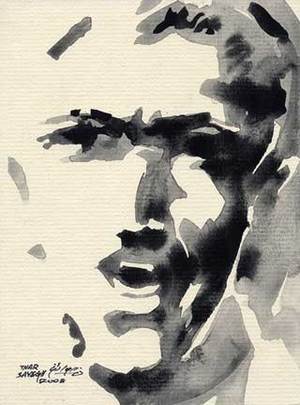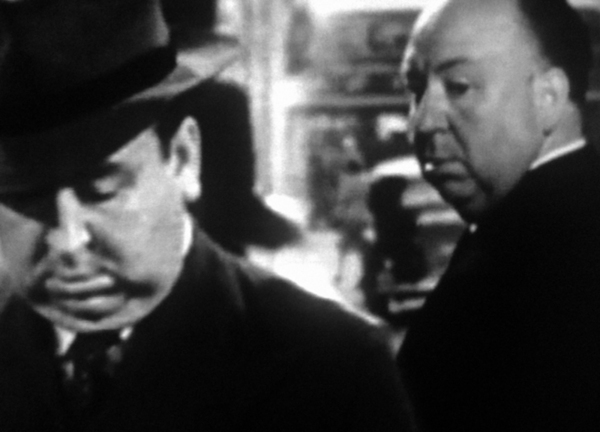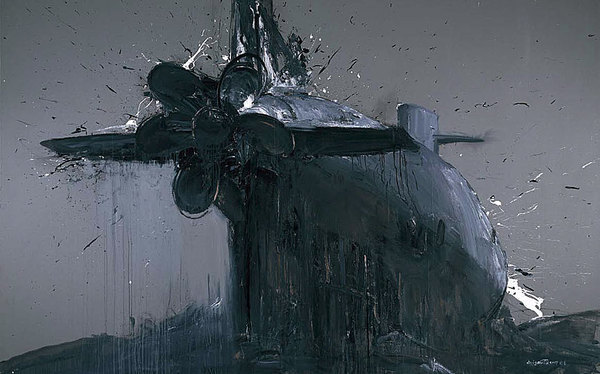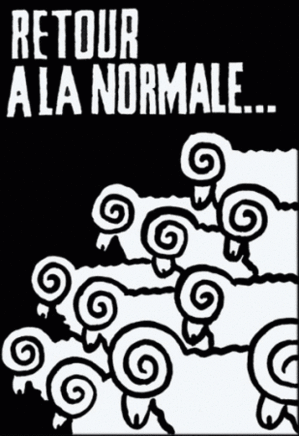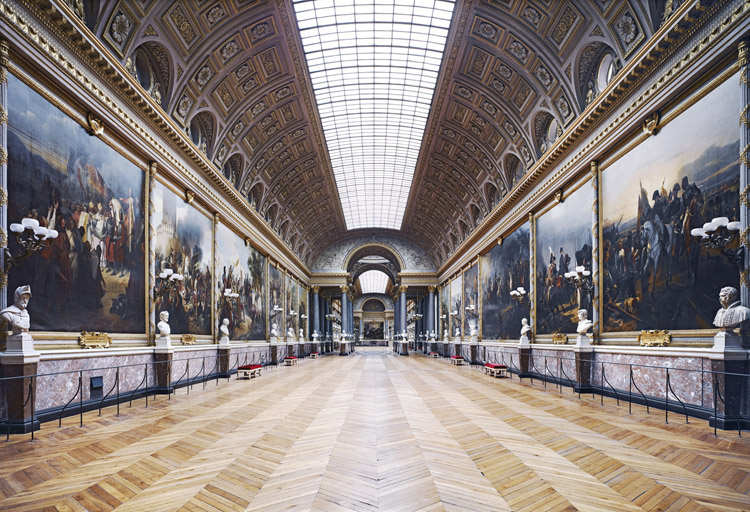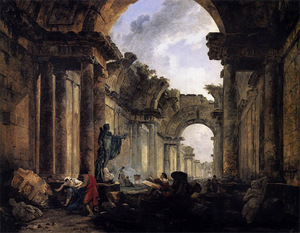This is an archive of the ArtCat Zine, 2007-2009. Please visit our new project, IDIOM.
Recently by Greg Afinogenov
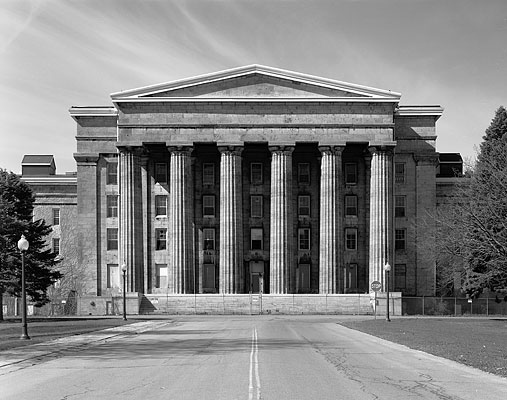
Asylum: Inside the Closed World of State Mental Hospitals
The Urban Center, New York NY
Friday, July 10, 2009
Straitjackets, cavernous hallways with peeling paint, a title cast in a well-worn sensationalistic mold: the marketing for Chris Payne's Friday presentation at the Architectural League of New York set up a familiar sort of expectation for me. I knew what I would hear. The photographer, fresh from a day trip to one of the more convenient asylum-hulks in the area, would play up the Gothic-horror angle, show lurid closeups of bloodstained old medical equipment, insinuate that the place was haunted, then hawk his book to the audience. I, too, showed up, ready to do my part — scribble “Foucault” in my notebook, quote some old situationist to the effect that “the newest school buildings are indistinguishable from the newest prisons or the newest industrial complexes,” and so on.
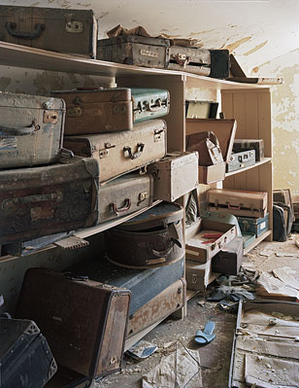
The reality was a pleasant surprise. Payne is no idle urban explorer; his project involves the careful photographic documentation of state mental hospitals all over the United States. He has a genuine affection for these old spaces, not because of their creepy ambiance, but because they are the remnants of self-sufficient little communities that once enclosed everything from dairy farms to power stations. For Payne, they represent an echo of an America that once was — a place where things were still made, where homes were more than faceless condominiums. (He is an architect by training, so it is unsurprising that the real horror for him is the asylums' gradual destruction at the hands of condo developers.) His photographs are thus suffused with a peculiarly poignant kind of nostalgia; in many cases, the buildings they depict have already been demolished.
The state mental hospitals, he explains, were built between the mid-nineteenth and early twentieth centuries, before psychotropic drugs and scientific psychiatry. (In fact, the Association of Medical Superintendents of American Institutions for the Insane was the precursor to the APA). In the absence of any reliable neurological treatment, the patients were offered complete isolation, natural surroundings and plenty of manual labor. At its height, the system housed over half a million people, the hospitals' farms and shops contributing to local economies throughout the country. In the postwar period, however, inmate labor was banned and a variety of new therapies made the asylums obsolete. Some still function; others are used as prisons or housing complexes, or simply stand empty.
Freedom and Beauty: The Art of Iraqi Refugees
St. Paul the Apostle - 405 W 59th St, New York NY
30 April - 28 May 2009
Everyone's talking about faith these days. In a recent issue of Commonweal, Terry Eagleton suggests that we ought to be attentive to the critical potentialities of religion; they are crucial, he thinks, because they provide an alternative to both radical fundamentalism and liberal-rationalist dogmatism. In a sense, it's easy to see what's at stake for him. Religion as a field of study now fills a niche once occupied by certain varieties of Marxism: it is, paradoxically, an ideologically uninvested space where adventurous approaches are welcomed rather than shunned. If its appropriations of Heidegger and Badiou are occasionally unrefined, it is because it's still something of a critical frontier.
The exhibition Freedom and Beauty: The Art of Iraqi Refugees, on view this month at St. Paul the Apostle Church, brings this frontier quality immediately to mind. Its engagement with theory, to be sure, is minimal. Nonetheless, the aggressive way in which it breaks with curatorial common sense is something of a statement in its own right. Paintings by four artists are arranged on a single display stand, crammed sardine-like into a few square feet. (Another artist is displayed on a slice of adjoining wall). The accompanying exposition in the press release and wall texts spends vanishingly little time on the paintings themselves. It focuses, rather, on the circumstances of their production, as even the title suggests. It describes the artists' experiences in war-torn Iraq and emigration, positioning the work itself as merely a response or an expression of the crisis — anything but l'art pour l'art.
But just as it makes little effort at any move towards something like contemporary exhibition practice, the exhibition also avoids making explicit political statements — it identifies neither culprits nor solutions — and, more strikingly, proselytizing. The objective seems to be the establishment of an interspace between traditionally ecclesiastical, artistic, and political sites and styles of dialogue. Though perhaps this is a grand claim for what is, after all, a fairly modest undertaking, its organizers are hardly strangers to such projects: the exhibition is the work of the Paulists, a missionary order that sees new media and cross-cultural exchange as fundamental to its evangelism. Freedom and Beauty, in short, represents a kind of religion even a Marxist like Eagleton can approve of. It is hard not to applaud the effort or appreciate its undermining of the borders between cultures and professions.
Double Take
Johan Grimonprez
Sean Kelly - 528 W. 29th St, New York NY
7 March - 21 March 2009
Folgers coffee has never been so apt a metaphor. Johan Grimonprez's new film Double Take, on view this month at Sean Kelly Gallery in Chelsea, is punctuated by several decades' worth of advertisements for it, and for good reason: it's the archetypal “double.” The doting wife, always unable to satisfy her husband's quasi-erotic demands for good brewed coffee, replaces it with instant. The husband can't tell the difference — but the audience is left with an uncanny sense of foreboding, as if its own coffee cups were in imminent danger of being surreptitiously substituted for something else. This vague anxiety is the foremost feeling evoked, and cultivated, by Grimonprez's film.
Double Take is a long and tightly-controlled examination of the double on a variety of levels, yet it remains admirably disciplined in its selection of motifs. The topic, after all, is so extensive and so firmly-rooted in Western culture — another artist would have felt obliged to reference Cervantes or Joseph Conrad — that a treatment trying for breadth would inevitably have become a catalogue.
Here, there are only a few primary strands to untangle. The spine of the story is provided by a Borges essay, reworked into a preternaturally plausible account of Alfred Hitchcock meeting his double. Hitchcock's doubles in fact populate the whole film, along with Hitchcock's own on-screen and off-screen personae. The difference between the two becomes less clear and less relevant as the narrative proceeds; by the end, we are left with barely anything more than the stylized, trademark silhouette, filled out by an ever-shifting array of characters. The original Hitchcock, it seems, cannot help becoming his own murder victim — for, the film insists, if you meet your double, you must kill him.
Evidence of a Lost Era
Cui Guotai
Chinasquare New York - 545 W. 25th St, 8th Fl, New York NY
1 October - 1 November 2008
Much ink has been spilled recently over the question of the economic crisis. There are some who want it to be a watershed, a sign that civilization can really break itself out of its contemporary dead end. We had heard over the past few decades that capitalist society had become post-industrial, a "postmodern condition" fueled by ever more abstract flows of global finance capital; today, it seems increasingly clear that what had looked like a qualitatively new form of socioeconomic existence is in fact bedeviled by the very same contradictions as the old. Appropriately, the crisis on Wall Street has not yielded any novel ideological solutions. On both sides of the ideological divide, sincerity has been replaced by desperation: the Right no longer believes in a pure market, only in the spoils of controlling the state apparatus, while the Left is scared to death of putting forward a new idea instead of dressing up the dessicated corpses of Social Democracy (which has proved unable to escape being implicated in the financial catastrophe) and Che Guevara quixotism. The crisis suggests the possibility that we might be forced into some truly new configuration, simply by the ineluctable logic of market events.
To believe this is to dream the great dream of the twentieth century — that the economic process could hold the key to a transformation of human existence. It was the stuff of science-fiction fantasies, to be sure, and served as the unconscious collective aspiration of bourgeois Great Societies. But it was equally the substance of the socialist vision. Collectivization, the first Five Year Plans, the Great Leap Forward: these were not simply economic policies but the outlines of a productivist utopianism that could overcome rather than resolve the class struggle. Productivism was fundamentally an aesthetic vision — look, for instance, at Marinetti in 1909:
We will sing of ... the gluttonous railway stations devouring smoking serpents; factories suspended from the clouds by the thread of their smoke; bridges with the leap of gymnasts flung across the diabolic cutlery of sunny rivers: adventurous steamers sniffing the horizon; great-breasted locomotives, puffing on the rails like enormous steel horses with long tubes for bridle, and the gliding flight of aeroplanes whose propeller sounds like the flapping of a flag and the applause of enthusiastic crowds.
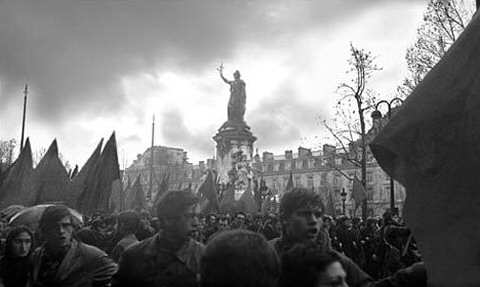
Actuellement : Regard Sur Mai 68: Photos, Musiques Et Voix
Alain Quemper
Dorothy's Gallery - 27 Rue Keller, Paris
11 April - 2 June 2008
The specter of May 1968 has been haunting us for forty years now, and it is time to put it to rest. This does not mean surrender, either to the rightist vision of a capitalism both benevolent and triumphant or to the reformist project of accommodation. Rather, it requires seeing this last gasp of revolution in the West for what it was: a failure as colossal in its implications as it was glorious in execution. "Those who make revolution halfway only dig their own graves," said the graffiti of the time, quoting Saint-Just. We — today's radicals — risk being buried alive in the grave May has dug for us.
For it was in fact a failure on many fronts. Not just in the obvious sense — the ensuing return of normalcy and a rightward electoral shift almost unprecedented in French history — but also in its successive reincarnations as a banner of the revolutionary left. The fact that May became a spectacularized image, a simulacrum, represents perhaps the greatest betrayal of its politics. Indeed, this is a central warning of Debord's Society of the Spectacle: the ideological image of the proletariat creates Bolshevism, while the ideological image of the revolutionary moment, the anarcho-syndicalist fantasy of the day of the general strike, cripples the capacity for real action. The fetishization of May does the anarchists one better. Rather than placing the magical moment of revolt in an always near but never achievable future, it relegates it to the dead and irretrievable time of the past. This facilitates the production and marketing of glossy, red-tinted souvenirs — from the works of Badiou to The Dreamers and the myriad wistful think-pieces in the left-wing dailies.
In fact, as « Regard sur mai 1968 » at Dorothy's Gallery in Paris suggests, there was never quite as total of a revolt as some imagine. The show exhibits a hundred (quite unremarkable) 1968 photographs by Alain Quemper. Of these, perhaps half a dozen depict the flag-waving revolutionary protesters we are used to seeing (and even these contain a fair number of bored or vaguely interested bystanders). Another dozen show scowling apparatchiks like Pompidou, angry at the unrest. But the rest — the overwhelming majority — show the smiling and content faces of the culture industry: actors, singers, athletes. They look as unruffled as they do in any other year; as students and workers made lofty speeches, the capitalist apparatus they represented continued blithely to chug on. In short, though the French government was briefly in danger, neither capitalism nor the State itself had anything to fear — it was a replay, not of 1789, but of 1830.
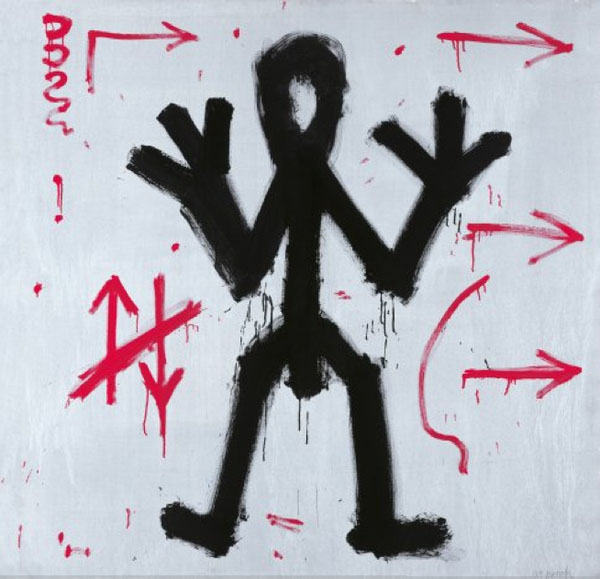
A. R. Penck
Musee d'Art moderne de la Ville de Paris
14 February – 11 May 2008
Ralf Winkler took his pseudonym, A. R. Penck, from the early twentieth-century geologist Albrecht Penck, an expert on the Ice Age. It was not an accidental choice: geology and "stored information," the artist says, have a certain affinity — and information is one of his most fundamental preoccupations. Penck is as much cyberneticist as painter. An elaborately conceived symbolic alphabet appears both directly and allegorically throughout his work, and his artistic project is constantly informed by the need to work through the implications of language, symbolic systems, communicative abstraction (thus, until the late '70s, Penck often accompanied his projects with theoretical texts).
Yet despite this very modern awareness of systems theory, his work consistently recalls the Ice Age in another way. Penck's artworks are not just vaguely primitivist: they are self-conscious evocations of the most ancient art. Penck sees his project as a "recourse to archeology," as "clearing a path through all of art history back to the cave paintings." This dialectical confrontation between the old and the new gives his painting a compelling, and unusual, pathos. The French sociologist Edgar Morin once described civilization as a passage from the problem of the caveman to the problem of the caves within man. Penck aims to attack both problems at once.
"I hope that these views appear to the spectator as they did to me — with a certain coldness."- Candida Höfer
Candida Höfer: Paris Series
8 March - 5 April 2008
Yvon Lambert Paris - 108 rue Vieille du Temple, Paris
The first thing that strikes the viewer about Candida Höfer's photographs is not their technical perfection, which is indubitable, but their sameness. Nearly all are of large, rectangular rooms, taken from the dead center of one of the shorter sides; in most, the light source is a skylight or a row of windows on the left-hand side. Human beings and their personal effects are nowhere to be found. The places depicted include some of Paris' most sumptuous Baroque interiors, yet the Bibliotheque Mazarine comes to look like Fontainebleau, the Bibliotheque du Senat like Versailles — as if the living details of each were an irrelevant and superficial skin over a fixed, immutable framework. In the accompanying video commentary, Höfer notes that she only shoots inside because "exterior spaces offer too many possibilities." Unsurprising.
For me, the most vivid counterpart and contrast to Höfer's work is that of the French Revolutionary artist Hubert Robert (1733-1808). Like Höfer, Robert emphasizes the grandeur of human-made spaces — yet his paintings lack the stillness and serenity of Höfer's photographs. He paints almost nothing but ruins: the destruction of bridges, the perishing in fire of great buildings, the crumbling hulks of vaguely classical temples. Perhaps his most famous work is an imagined scene of the Grand Gallery of the Louvre in ruins, the vaulted ceiling caved in, a cooking fire where statues once stood. Robert's subjects, both the ruins themselves and the people that inhabit them, are presented in their utmost vulnerability to history; like Robert himself, they live in a world constantly overshadowed by historical rupture, where even the solidity of stone is no guarantee of permanence.
ZINE
HOME
TIPS / COMMENTS
CATEGORIES
CONTRIBUTORS
- Greg Afinogenov
- B. Blagojevic
- Adda Birnir
- Susannah Edelbaum
- Julie Fishkin
- Paddy Johnson
- Jessica Loudis
- Christopher Reiger
- Andrew Robinson
- Peter J. Russo
- Blythe Sheldon
- S.C.Squibb
- Hrag Vartanian

